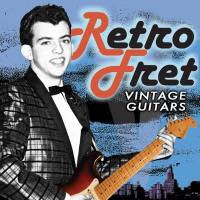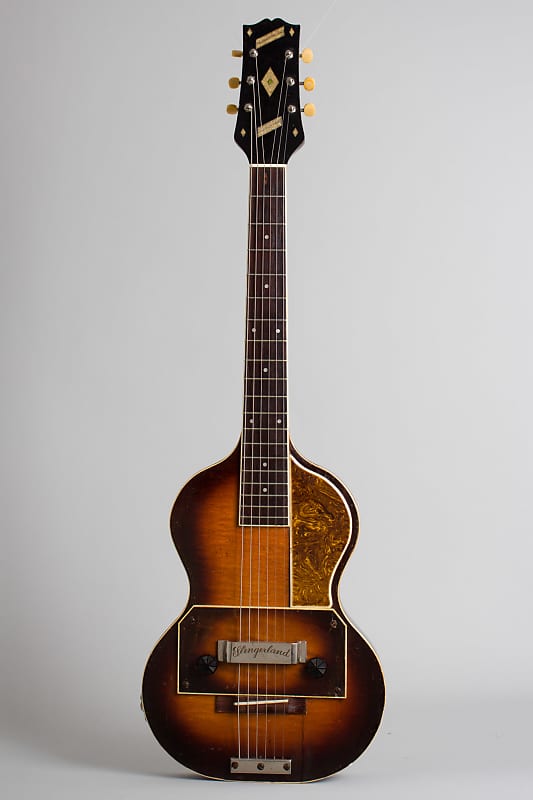

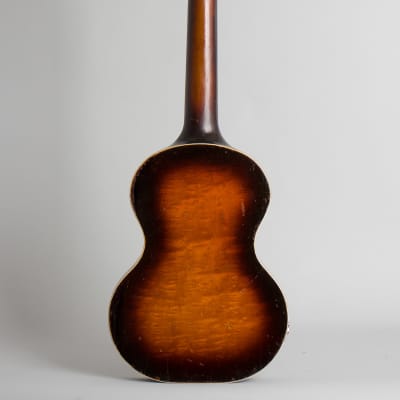
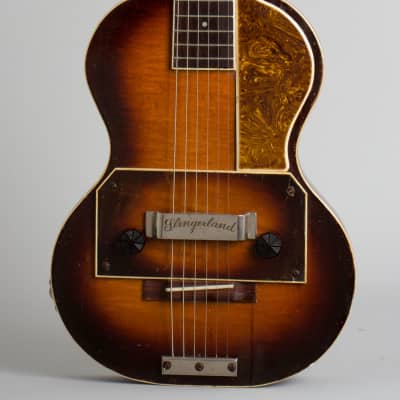
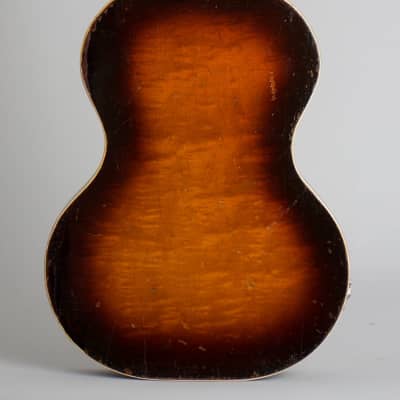
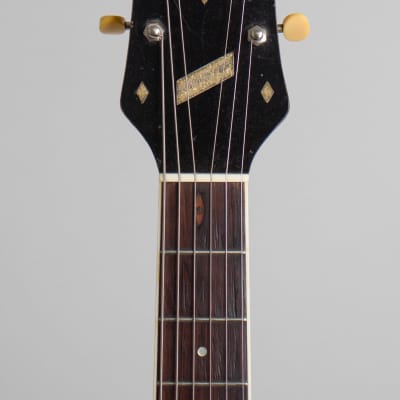
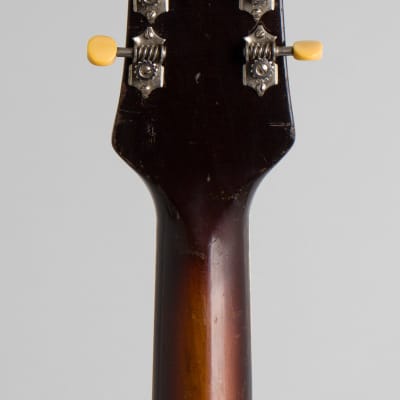
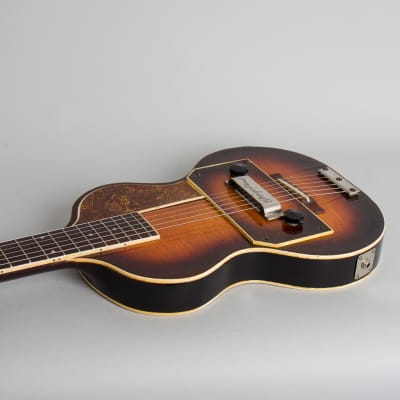
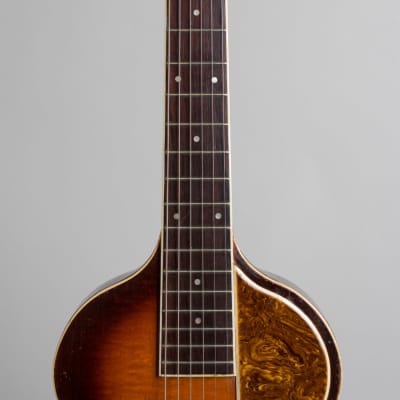
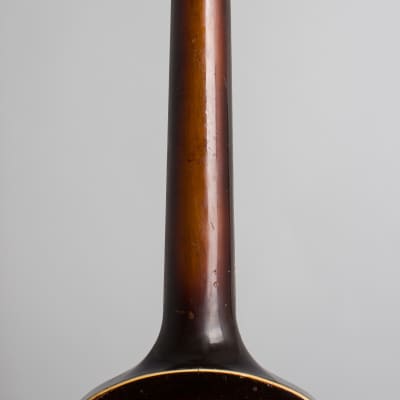
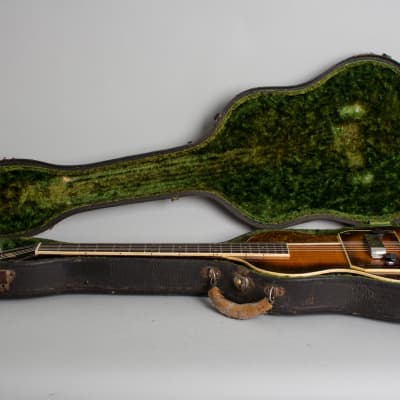
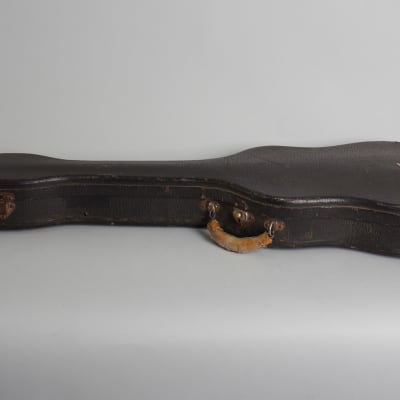
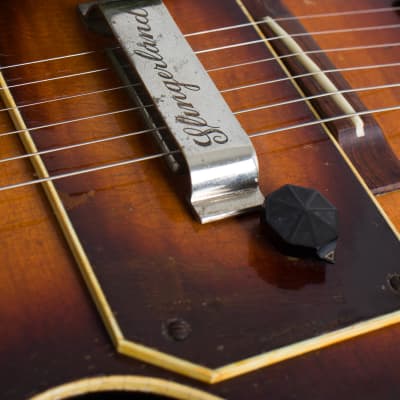
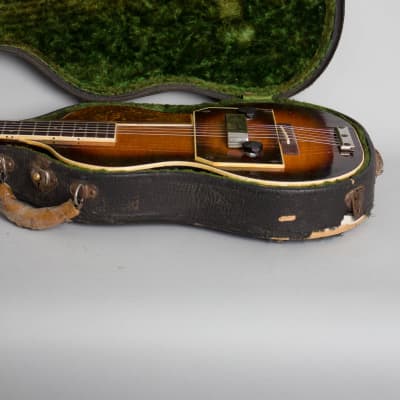
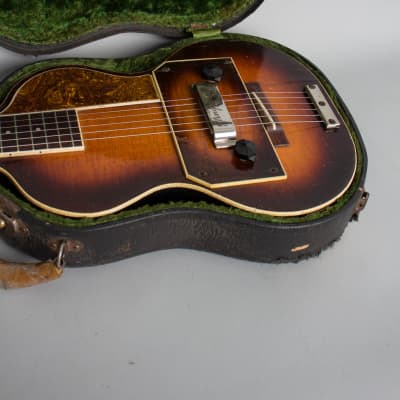
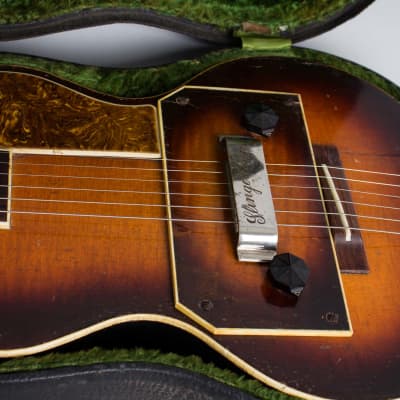
Slingerland Songster Model 401 Model Solid Body Electric Guitar (1936), made in Chicago, serial # 132, sunburst lacquer finish, maple body, mahogany neck with rosewood fingerboard, original black hard shell case. This is by far the most playable example of this historically important if extremely obscure early solidbody electric we have ever had. While sold as a standard Spanish-style instrument most of the few surviving examples of this Slingerland Model 401 have neck angles too shallow to be functionally playable without major modification. This one is the happy exception, with a nice straight neck, good frets and a very comfortable action. Although hardly remembered today, the Slingerland Songster Model 401 is one of the most interesting and original of early electric instruments with its solid wood body. It was the most forward-looking electric guitar of its time, effectively predicting many later developments in electric guitars of the 1950s and beyond. Slingerland basically had the elements that would make up Gibson's Les Paul in place by 1936-7, but never followed through!The Slingerland name is usually more associated with drums; their market leading 1930s "Radio King" line established the layout of the modern drum kit. The brand is also familiar to vintage banjo enthusiasts, as they made thousands of mostly cheap banjos in the '20s and '30s. Even when prospering with drums, the company continued to make a full line of acoustic guitars, mandolins, and ukuleles ranging from cheap student-level "bangers" to professional-quality instruments.In the mid-1930s Slingerland introduced their first electric models, two variants on the same plan. The "Songster 400 Hawaiian" was broadly similar to the contemporary Gibson EH-150, with some interesting differences. This fairly rare steel is prized for its great tone and stylish Deco look. Its far more obscure sister instrument, the "Model 401 Spanish", is something else altogether. Representing a major step forward for amplified instruments, this was the first wooden round neck, solid-body electric Spanish guitar.There are earlier claimants to the title "first solid-body guitar", but they are more eccentric designs. The Vivi-Tone company introduced their "plank" solid electric in 1932 built around Lloyd Loar's vibration-sensing pickup. The Rickenbacher Electro Spanish model, introduced in 1935, was a variant of their Model B Bakelite lap steel but with a round, Spanish-style molded Bakelite neck. While the Hawaiian Model B went on to great success, the Spanish model with molded-in frets was an eccentric player at best and a commercial dud.The oddly visionary Slingerland 401 comes much closer than these to the future solid-body guitar layout. The earliest Spanish electric with a solid wood body, it was also the first built with a through-neck design. The poplar center section is joined to two body wings, with flamed maple veneers covering the top and back. The unique pickup is a quite powerful six-coil design with humbucking properties -- two decades before Gibson claimed that idea. Each string has its own coil beneath it, with a large magnet hidden under the wooden coverplate providing the "juice". Tone and volume controls are located lap-steel style on either side of the metal handrest/pickup cover, which is daintily engraved with the company's name in flowing script. The black plastic-covered headstock matches the Songster guitar and mandolin line, with diamonds of sparkle-infused plastic inlaid into the veneer; a typical touch for a company that made drums. The guitar originally connected to the amplifier with a hard-wired cloth-covered cord; while awkward to modern players, this was fairly common on 1930s steels.The Model 401 was introduced in late 1936, about a year after the Bakelite Rickenbacker. The guitar was priced at $75, plus $15 for the fairly deluxe case and another $75 for the amp. This was exactly in line with Gibson's pricing, and as with the Kalamazoo rival you could purchase the set of guitar, amp, and case together for $150. This one carries serial number 132 which is the earliest we have seen although after the first batch the company seems to have no longer bothered to number them.In common with the other electric solid-body designs in the '30s, the non-acoustic sounding Slingerland 401 was alien to the primarily rhythmic guitar styles of the day. The styles of playing calling for such an instrument simply did not exist yet; players saw no reason to adapt to its quirky feel and VERY few were sold. The Slingerland Songster model 401 may be nearly forgotten except by historians today, but it is one of the most significant of all early amplified guitars, and the most advanced electric fretted concept of its day. This exact guitar is pictured on page 144 of the recent THE PINEECASTER book, where author Lynn Wheelwright tell their story. And it still SOUNDS fantastic!Overall length is 37 in. (94 cm.), 11 1/2 in. (29.2 cm.) wide
Reverb Buyer Protection
Reverb has your back if your item is lost, damaged, or doesn't match its description. Simply report any issues within 7 days and we'll help you get a full refund.Learn more about Reverb Buyer Protection.
| Listed | 7 months ago |
| Condition | Very Good (Used) Very Good items may show a few slight marks or scratches but are fully functional and in overall great shape.Learn more |
| Brand | |
| Model |
|
| Finish |
|
| Categories | |
| Year |
|
| Body Type |
|
